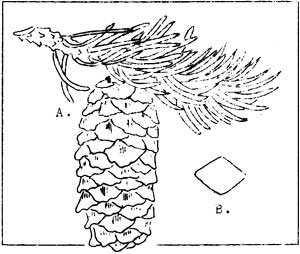ENGELMAN SPRUCE.
(Picea engelmanni)
This tree is found only on the north side of the park. It is quite
abundant on Chenuis Mountain, in the northwest section, between 4500 and
6000 feet, and in the northeast corner where it occurs between 4500 and
6500 feet in the White River-Yakima Park region. In the latter area it
can be most readily found in the vicinity of the White River camp
ground.

ENGELMAN SPRUCE (Picea engelmanni). A - Cone and foliage
(x1). B - Diagramatic cross section of a needle, illustrating the
characteristic diamond shape (x10).
|
In some parts of its botanical range the Engelman spruce attains a
fairly good size but in Mount Rainier National Park it is, at
best, a rather small tree, being from 20-60 feet tall and 6-20
inches in diameter in the more favorable locations. At high
elevations, of course, it is much smaller. The crown is long,
dense, and compact. The lower branches are long, often reaching
to the ground, while those on the upper portions of the tree are,
successively shorter so that the crown narrows to the stiff, erect
spike-like central leader. The bark is thin, scaly and dark
purple-brown to russet brown in color. The foliage is deep
blue-green, the individual needles being one inch or less in length,
four-sided in cross section, pointed at the tip and very prickly to the
touch - a character that readily identifies it from its associates.
Individual needles are borne on small woody leaf bases which persist
upon the twigs after the needles have dropped off to give these twigs a
rough appearance which is characteristic of all spruces. The
cones mature in one season and are generally borne abundantly
upon the upper branches. They are usually about 2 inches long, a light
glossy brown and composed of numerous thin, papery scales.
This tree has a wide botanical range and in some sections it
is of considerable importance as a timber tree. It will be found from
the Yukon south to Oregon on the Pacific Coast and, in the Rocky
Mountains, as far south as New Mexico and Arizona.
-oOo-
SITKA SPRUCE.
(Picea sitchensis)
Because of its exceedingly limited occurrence in Mount Rainier
National Park, it is not likely that the Sitka spruce will be
encountered by the average park visitor. It is more properly a species
of the low elevations, being a particularly abundant and important tree
along the sea coast. However, it extends inland via deep river valleys
and is found very sparingly on the west side of the park up to about
2600 feet. Specimens have been noted in the Carbon and North Puyallup
river bottoms near the western park boundary.
The tree has thin, scaly, reddish-brown bark. The
foliage is bright green, the individual needles being borne upon
persistent woody leaf bases as in the case of the Engelman spruce, but,
unlike that species, the needles of the Sitka spruce are not four-angled
in cross section - being plump and roundish in cross section instead.
The cones which mature in one season, are from 2-4 inches long,
light brown in color, and are composed of numerous thin, papery
scales.
This species ranges along the Pacific Coast from Alaska to northern
California.
-oOo-
Descriptions continued...

